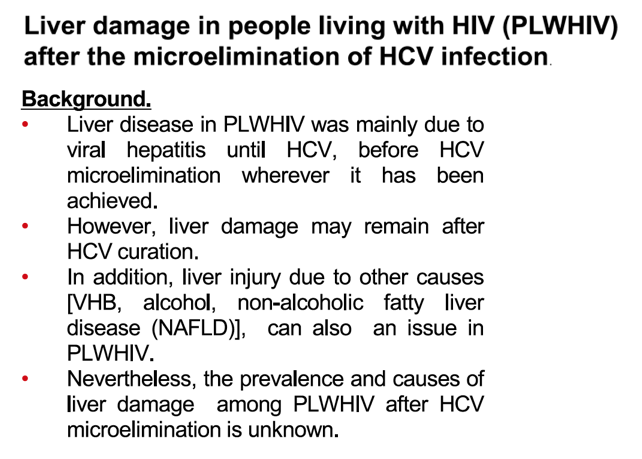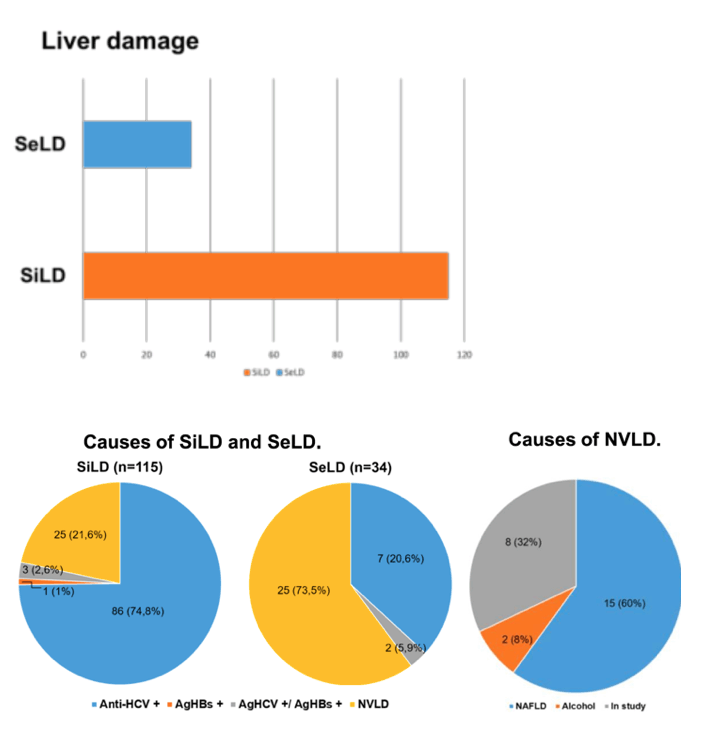 |
 |
 |
| |
Liver disease in people living with HIV (PLWHIV) after
the microelimination of HCV infection: non-viral hepatitis & NAFLD
|
| |
| |
EACS 2021 Oct 27-30
M. Santos1, J. Macías-Sánchez1, M. Fernandez-Fuertes1, D. de la Rosa-Muñoz2, A. Corma-Gomez1, P. Rincón1, A. Gonzalez-Serna1, E. Rodriguez-Pineda1, L.M. Real1, J.A. Pineda-Vergara1
1Hospital Universitario de Valme, Infectious Diseases, Sevilla, Spain, 2Universidad de Sevilla, Internal Medicine, Sevilla, Spain

Abstract
Purpose or Objective
Liver disease in PLWHIV was mainly due to viral hepatitis until HCV was microeliminated in many areas. However, liver damage may remain after HCV curation. Liver injury due to other causes may also be an issue. Nevertheless, the current prevalence of liver disease and its etiology is unknown. Our aim was to analyze the frequency of hepatic disease and its etiology in PLWHIV in our area.
Results
Cross-sectional study (Southern Spain, 2019-2020). Liver stiffness measurement (LSM) and controlled attenuation parameter (CAP) were obtained. Significant hepatic injury (SHI) was defined as LSM ≥7.2 KPa (two LSM separated >3 months), and severe liver damage (SLD) as LSM ≥14 KPa. PLWHIV with SHI were diagnosed with non-viral liver disease (NVLD) if HBsAg, anti-HCV and anti-HEV were negative. Among PLWHIV with NVLD, NAFLD was diagnosed if CAP >248 dB/m or with criteria for metabolic syndrome; alcohol was considered if AUDIT-C ≥4 in women or ≥5 in men.
Materials and Methods
714 patients were included. 549 (71.3%) had valid LSM, 136 (24.8%) had SHI, and 32 (5.8%) had LS ≥14 KPa. SHI was associated with: anti-HCV positive (all with undetectable viral load), 77 (74%); HBsAg positive, 1 (1%); both, 3 (3%); NVLD, 23 (22%). The cause of LSM ≥14 KPa was: HCV, 23 (71.8%); HCV/HBV co-infection, 2 (6.3%); NVLD, 7 (21.9%). The frequency of NVLD was 4.2%, and the etiology was: NAFLD, 14 (60.9%); alcohol, 2 (8.7%); mixed, 2 (8.7%); under evaluation, 5 (21.7%).
Conclusion
Currently, a relevant proportion of PLWHIV suffer SHI, including SLD. SHI in our setting is mainly due to residual HCV infection. NVLD, mostly NAFLD and alcohol-related, is also an important cause of liver disease. In the post-HCV era, screening liver disease in PLWHIV is still essential.



|
| |
|
 |
 |
|
|